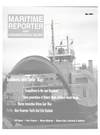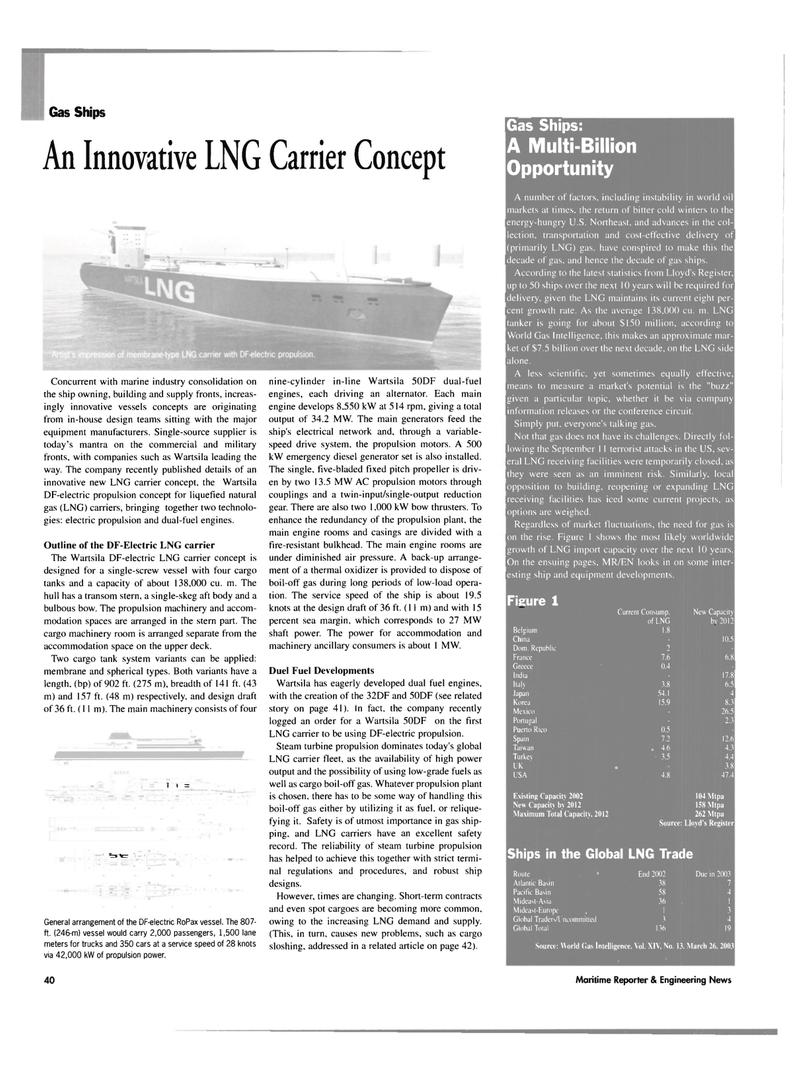
Page 40: of Maritime Reporter Magazine (May 2003)
Read this page in Pdf, Flash or Html5 edition of May 2003 Maritime Reporter Magazine
Gas Ships:
A Multi-Billion
Opportunity
A number of factors, including instability in world oil markets at times, the return of bitter cold winters to the energy-hungry U.S. Northeast, and advances in the col- lection. transportation and cost-effective delivery of (primarily LNG) gas, have conspired to make this the decade of gas, and hence the decade of gas ships.
According to the latest statistics from Lloyd's Register, up to 50 ships over the next 10 years will be required for delivery, given the LNG maintains its current eight per- cent growth rate. As the average 138.000 cu. m. LNG tanker is going for about $150 million, according to
World Gas Intelligence, this makes an approximate mar- ket of $7.5 billion over the next decade, on the LNG side alone.
A less scientific, yet sometimes equally effective, means to measure a market's potential is the "buzz" given a particular topic, whether it be via company information releases or the conference circuit.
Simply put. everyone's talking gas.
Not that gas does not have its challenges. Directly fol- lowing the September 11 terrorist attacks in the US, sev- eral LNG receiving facilities were temporarily closed, as they were seen as an imminent risk. Similarly, local opposition to building, reopening or expanding LNG receiving facilities has iced some current projects, as options are weighed.
Regardless of market fluctuations, the need for gas is on the rise. Figure 1 shows the most likely worldwide growth of LNG import capacity over the next 10 years.
On the ensuing pages, MR/EN looks in on some inter- esting ship and equipment developments.
Figure 1
Current Consump. New Capacity of LNG by 2012
Belgium 1.8
China j - 10.5
Dom. Republic 2'f+
France 7.6 6.8
Greece 0.4 •4
India - 17.8
Italy 3.8 6.5
Japan 54.1 4
Korea 15.9 i 8.3
Mexico - 26.5
Portugal - 23
Puerto Rico 0.5 -
Spain 7.2 12.6
Taiwan o 4.6 4.3
Turkey • 3.5 4.4
UK O 3.8
USA 4.8 47.4
Existing Capacity 2002 104 Mtpa
Ne» Capacity by 2012 158 Mtpa
Maximum Total Capacity, 2012 262 Mtpa
Source: Lloyd's Register
Ships in the Global LNG Trade
Route ° End 2002 Due in 2003
Atlantic Basin 38 7
Pacific Basin 58 4
Mideast-Asia 6 I
Mideasl-Furope , 1 3
Global Traders/Uncommitted 3 4
Global Total 136 19
Source: World Gas Intelligence. Vol. XIV, No. 13. March 26.2003
Gas Ships
An Innovative LNG Carrier Concept
Concurrent with marine industry consolidation on the ship owning, building and supply fronts, increas- ingly innovative vessels concepts are originating from in-house design teams sitting with the major equipment manufacturers. Single-source supplier is today's mantra on the commercial and military fronts, with companies such as Wartsila leading the way. The company recently published details of an innovative new LNG carrier concept, the Wartsila
DF-electric propulsion concept for liquefied natural gas (LNG) carriers, bringing together two technolo- gies: electric propulsion and dual-fuel engines.
Outline of the DF-Electric LNG carrier
The Wartsila DF-electric LNG carrier concept is designed for a single-screw vessel with four cargo tanks and a capacity of about 138,000 cu. m. The hull has a transom stern, a single-skeg aft body and a bulbous bow. The propulsion machinery and accom- modation spaces are arranged in the stern part. The cargo machinery room is arranged separate from the accommodation space on the upper deck.
Two cargo tank system variants can be applied: membrane and spherical types. Both variants have a length, (bp) of 902 ft. (275 m), breadth of 141 ft. (43 m) and 157 ft. (48 m) respectively, and design draft of 36 ft. (11 m). The main machinery consists of four
I t = eafte
General arrangement of the DF-electric RoPax vessel. The 807- ft. (246-m) vessel would carry 2,000 passengers, 1,500 lane meters for trucks and 350 cars at a service speed of 28 knots via 42,000 kW of propulsion power. nine-cylinder in-line Wartsila 50DF dual-fuel engines, each driving an alternator. Each main engine develops 8,550 kW at 514 rpm, giving a total output of 34.2 MW. The main generators feed the ship's electrical network and, through a variable- speed drive system, the propulsion motors. A 500 kW emergency diesel generator set is also installed.
The single, five-bladed fixed pitch propeller is driv- en by two 13.5 MW AC propulsion motors through couplings and a twin-input/single-output reduction gear. There are also two 1,000 kW bow thrusters. To enhance the redundancy of the propulsion plant, the main engine rooms and casings are divided with a fire-resistant bulkhead. The main engine rooms are under diminished air pressure. A back-up arrange- ment of a thermal oxidizer is provided to dispose of boil-off gas during long periods of low-load opera- tion. The service speed of the ship is about 19.5 knots at the design draft of 36 ft. (11 m) and with 15 percent sea margin, which corresponds to 27 MW shaft power. The power for accommodation and machinery ancillary consumers is about 1 MW.
Duel Fuel Developments
Wartsila has eagerly developed dual fuel engines, with the creation of the 32DF and 50DF (see related story on page 41). In fact, the company recently logged an order for a Wartsila 50DF on the first
LNG carrier to be using DF-electric propulsion.
Steam turbine propulsion dominates today's global
LNG carrier fleet, as the availability of high power output and the possibility of using low-grade fuels as well as cargo boil-off gas. Whatever propulsion plant is chosen, there has to be some way of handling this boil-off gas either by utilizing it as fuel, or relique- fying it. Safety is of utmost importance in gas ship- ping, and LNG carriers have an excellent safety record. The reliability of steam turbine propulsion has helped to achieve this together with strict termi- nal regulations and procedures, and robust ship designs.
However, times are changing. Short-term contracts and even spot cargoes are becoming more common, owing to the increasing LNG demand and supply. (This, in turn, causes new problems, such as cargo sloshing, addressed in a related article on page 42). 40 Maritime Reporter & Engineering News

 39
39

 41
41
